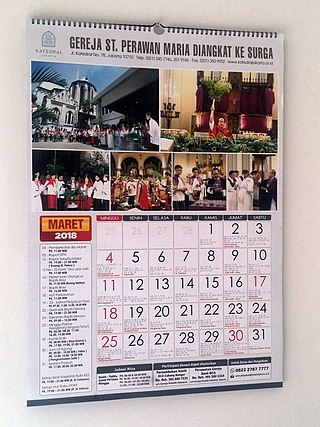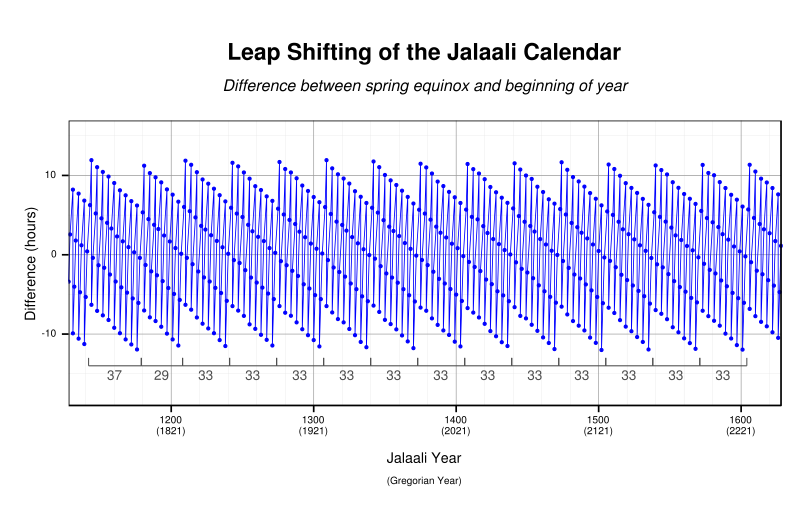
A calendar is a system of organizing days. This is done by giving names to periods of time, typically days, weeks, months and years. A date is the designation of a single and specific day within such a system. A calendar is also a physical record of such a system. A calendar can also mean a list of planned events, such as a court calendar, or a partly or fully chronological list of documents, such as a calendar of wills.
Generally speaking, a calendar year begins on the New Year's Day of the given calendar system and ends on the day before the following New Year's Day, and thus consists of a whole number of days. A year can also be measured by starting on any other named day of the calendar, and ending on the day before this named day in the following year. This may be termed a "year's time", but not a "calendar year". To reconcile the calendar year with the astronomical cycle certain years contain extra days. The Gregorian year, which is in use in most of the world, begins on January 1 and ends on December 31. It has a length of 365 days in an ordinary year, with 8760 hours, 525,600 minutes, or 31,536,000 seconds; but 366 days in a leap year, with 8784 hours, 527,040 minutes, or 31,622,400 seconds. With 97 leap years every 400 years, the year has an average length of 365.2425 days. Other formula-based calendars can have lengths which are further out of step with the solar cycle: for example, the Julian calendar has an average length of 365.25 days, and the Hebrew calendar has an average length of 365.2468 days. The Lunar Hijri calendar is a lunar calendar consisting of 12 months in a year of 354 or 355 days. The astronomer's mean tropical year, which is averaged over equinoxes and solstices, is currently 365.24219 days, slightly shorter than the average length of the year in most calendars.

The Hijri calendar, or Arabic calendar also known in English as the Muslim calendar and Islamic calendar, is a lunar calendar consisting of 12 lunar months in a year of 354 or 355 days. It is used to determine the proper days of Islamic holidays and rituals, such as the annual fasting and the annual season for the great pilgrimage. In almost all countries where the predominant religion is Islam, the civil calendar is the Gregorian calendar, with Syriac month-names used in the Levant and Mesopotamia but the religious calendar is the Hijri one.
Intercalation or embolism in timekeeping is the insertion of a leap day, week, or month into some calendar years to make the calendar follow the seasons or moon phases. Lunisolar calendars may require intercalations of days or months.
A leap year is a calendar year that contains an additional day compared to a common year. The 366th day is added to keep the calendar year synchronised with the astronomical year or seasonal year. Since astronomical events and seasons do not repeat in a whole number of days, calendars having a constant number of days each year will unavoidably drift over time with respect to the event that the year is supposed to track, such as seasons. By inserting ("intercalating") an additional day—a leap day—or month—a leap month—into some years, the drift between a civilization's dating system and the physical properties of the Solar System can be corrected.
A lunar calendar is a calendar based on the monthly cycles of the Moon's phases, in contrast to solar calendars, whose annual cycles are based on the solar year. The most widely observed purely lunar calendar is the Islamic calendar. A purely lunar calendar is distinguished from a lunisolar calendar, whose lunar months are brought into alignment with the solar year through some process of intercalation – such as by insertion of a leap month. The details of when months begin vary from calendar to calendar, with some using new, full, or crescent moons and others employing detailed calculations.

A lunisolar calendar is a calendar in many cultures, incorporating lunar calendars and solar calendars. The date of lunisolar calendars therefore indicates both the Moon phase and the time of the solar year, that is the position of the Sun in the Earth's sky. If the sidereal year is used instead of the solar year, then the calendar will predict the constellation near which the full moon may occur. As with all calendars which divide the year into months there is an additional requirement that the year have a whole number of months. In some cases ordinary years consist of twelve months but every second or third year is an embolismic year, which adds a thirteenth intercalary, embolismic, or leap month.
A month is a unit of time, used with calendars, that is approximately as long as a natural orbital period of the Moon; the words month and Moon are cognates. The traditional concept of months arose with the cycle of Moon phases; such lunar months ("lunations") are synodic months and last approximately 29.53 days, making for roughly 12.37 such months in one Earth year. From excavated tally sticks, researchers have deduced that people counted days in relation to the Moon's phases as early as the Paleolithic age. Synodic months, based on the Moon's orbital period with respect to the Earth–Sun line, are still the basis of many calendars today and are used to divide the year.

A year is the time taken for astronomical objects to complete one orbit. For example, a year on Earth is the time taken for Earth to revolve around the Sun. Generally, a year is taken to mean a calendar year, but the word is also used for periods loosely associated with the calendar or astronomical year, such as the seasonal year, the fiscal year, the academic year, etc. The term can also be used in reference to any long period or cycle, such as the Great Year.
A solar calendar is a calendar whose dates indicate the season or almost equivalently the apparent position of the Sun relative to the stars. The Gregorian calendar, widely accepted as a standard in the world, is an example of a solar calendar. The main other types of calendar are lunar calendar and lunisolar calendar, whose months correspond to cycles of Moon phases. The months of the Gregorian calendar do not correspond to cycles of the Moon phase.
The Iranian calendars or Iranian chronology are a succession of calendars created and used for over two millennia in Iran, also known as Persia. One of the longest chronological records in human history, the Iranian calendar has been modified many times for administrative, climatic, and religious purposes. The most influential person in laying the frameworks for the calendar and its precision was the 11th century Persian polymath, Omar Khayyam. The modern Iranian calendar is currently the official civil calendar in Iran.

Nowruz or Navroz is the Iranian New Year or Persian New Year. Historically, it has been observed by Persians and other Iranian peoples, but is now celebrated by many ethnicities worldwide. It is a festival based on the Northern Hemisphere spring equinox, which marks the first day of a new year on the Solar Hijri calendar; it usually coincides with a date between 19 March and 22 March on the Gregorian calendar.

Adherents of Zoroastrianism use three distinct versions of traditional calendars for liturgical purposes, all derived from medieval Iranian calendars and ultimately based on the Babylonian calendar as used in the Achaemenid empire. Qadimi ("ancient") is a traditional reckoning introduced in 1006. Shahanshahi ("imperial") is a calendar reconstructed from the 10th century text Denkard.
The Baháʼí calendar used in the Baháʼí Faith is a solar calendar consisting of nineteen months and four or five intercalary days, with new year at the moment of Northern spring equinox. Each month is named after a virtue, as are the days of the week. The first year is dated from 1844 CE, the year in which the Báb began teaching.
Calendar reform or calendrical reform is any significant revision of a calendar system. The term sometimes is used instead for a proposal to switch to a different calendar design.
The Islamic New Year, also called the Hijri New Year, is the day that marks the beginning of a new lunar Hijri year, and is the day on which the year count is incremented. The first day of the Islamic year is observed by most Muslims on the first day of the month of Muharram. The epoch of the Islamic era was set as the year of the emigration of Muhammad and his followers from Mecca to Medina, known as the Hijrah, which equates to 622 CE in the Gregorian calendar. All religious duties, such as prayer, fasting in the month of Ramadan, and pilgrimage, and the dates of significant events, such as celebration of holy nights and festivals, are calculated according to the Islamic calendar.
The Hijri year or era is the era used in the Islamic lunar calendar. It begins its count from the Islamic New Year in which Muhammad and his followers migrated from Mecca to Yathrib in 622 CE. This event, known as the Hijrah, is commemorated in Islam for its role in the founding of the first Muslim community (ummah).
Farvardin is the Iranian Persian name for the first month of the Solar Hijri calendar, the official calendar of Iran, and corresponds with Aries on the Zodiac. Farvardin has thirty-one days. It is the first month of the spring season (Bahar), and is followed by Ordibehesht. The Afghan Pashto name for it is Wray.
The Jalali calendar, also referred to as Malikshahi and Maliki, is a solar calendar compiled during the reign of Jalaluddin Malik-Shah I, the Sultan of the Seljuk Empire, by the order of Grand Vizier Nizam al-Mulk, using observations made in the cities of Isfahan, Rey, and Nishapur. Variants of the Jalali calendar are still in use today in Iran and Afghanistan. In Iran, the Persian names of the zodiac are used, while in Afghanistan the original Arabic names are used. The Jalali calendar gains approximately 1 day on the Julian calendar every 128 years.
The Gregorian calendar is the calendar used in most parts of the world. It went into effect in October 1582 following the papal bull Inter gravissimas issued by Pope Gregory XIII, which introduced it as a modification of, and replacement for, the Julian calendar. The principal change was to space leap years differently so as to make the average calendar year 365.2425 days long, more closely approximating the 365.2422-day 'tropical' or 'solar' year that is determined by the Earth's revolution around the Sun.








